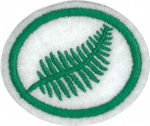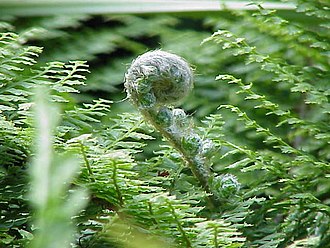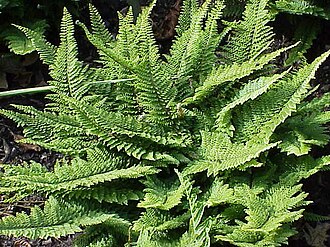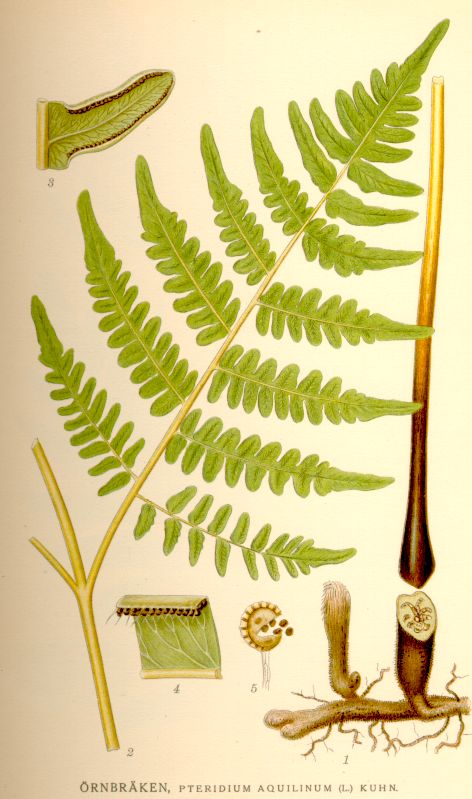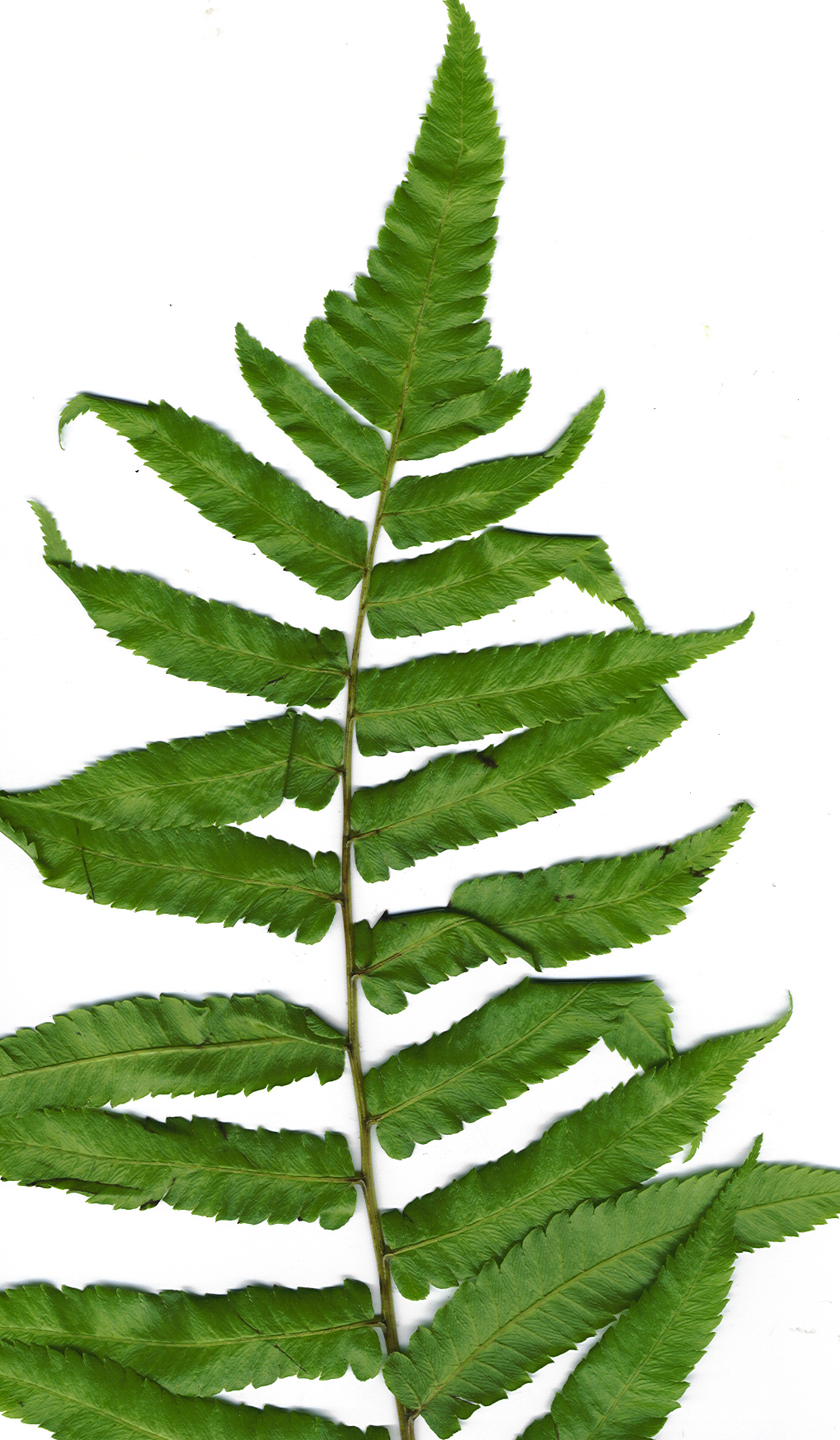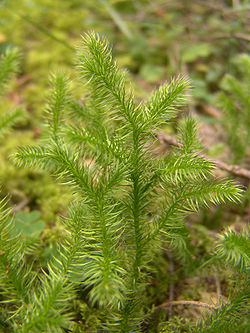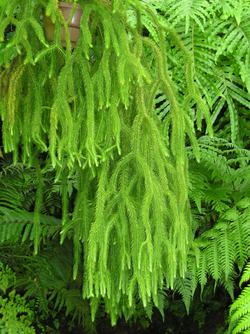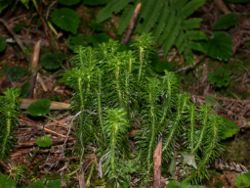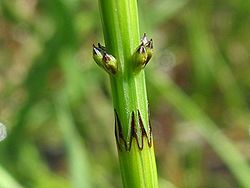Difference between revisions of "AY Honors/Ferns/Answer Key/es"
(Created page with "{{clear}}") |
(Created page with "</noinclude> <!-- 4. ¿Cómo viajan las esporas de la planta a una nueva ubicación? ¿Cuánto tiempo tarda una espora en desarrollar una planta madura? Observar de helechos v...") |
||
| Line 56: | Line 56: | ||
{{ansreq|page={{#titleparts:{{PAGENAME}}|2|1}}|num=4}} | {{ansreq|page={{#titleparts:{{PAGENAME}}|2|1}}|num=4}} | ||
<noinclude></noinclude> | <noinclude></noinclude> | ||
| − | <!-- 4. | + | <!-- 4. ¿Cómo viajan las esporas de la planta a una nueva ubicación? ¿Cuánto tiempo tarda una espora en desarrollar una planta madura? Observar de helechos vivos o imágenes cómo un helecho joven es diferente de un helecho adulto. --> |
| − | |||
If the spore lands in a location with favorable conditions, it will develop into a gametophyte in about two weeks. If the gametophyte is fertilized, it will grow into a young fern in about 3 and a half months. The amount of time required for these growth periods varies greatly depending on conditions and the species. | If the spore lands in a location with favorable conditions, it will develop into a gametophyte in about two weeks. If the gametophyte is fertilized, it will grow into a young fern in about 3 and a half months. The amount of time required for these growth periods varies greatly depending on conditions and the species. | ||
Revision as of 03:30, 20 February 2021
| Helechos | ||
|---|---|---|
| Asociación General
|
Destreza: 2 Año de introducción: 1944 |
|
Requisitos
|
La especialidad de Helechos es un componente de la Maestría Naturaleza. |
| Conexión Logros para la Investidura: Esta especialidad está relacionada con los requisitos de Logros para la Investidura para EXPLORADOR DE CAMPO Y BOSQUE Estudio de la naturaleza que requiere (como una de dos opciones) completar el requisito #6 de esta especialidad. Esta especialidad es una elección popular para la especialidad de la categoría de Estudio de la naturaleza de nivel de destreza 2 o 3 requerido para los EXPLORADORES DE CAMPO Y BOSQUE. |
1
2
3
4
If the spore lands in a location with favorable conditions, it will develop into a gametophyte in about two weeks. If the gametophyte is fertilized, it will grow into a young fern in about 3 and a half months. The amount of time required for these growth periods varies greatly depending on conditions and the species.
Below are examples of a young fern still in the fiddlehead stage, and a mature frond of the same species.
5
- Adiantum aleuticum (Western Maidenhair Fern)
- Frond tea is used to strengthen mucosal membranes, treat coughs, throat congestion, and respiratory irritation caused by air pollution.
- Asplenium scolopendrium (Hart's-tongue Fern)
- This fern had use in folk medicine as a spleen tonic.
- Cibotium menziesii (Hawaiian Tree Fern)
- The pith of the trunk is used in a combination of other Hawaiian plants to create a 'blood purifier', and is used in other combinations to help relieve weakness or chest pains. Heated fibres of the fronds are used to cure numerous bodily ailments such as muscle pain, stiff joints etc.
- Phlebodium aureum (Cabbage palm fern)
- Its uses include:
- for psoriasis and other skin conditions
- for Alzheimer's disease, dementia, and memory problems
- for coughs, bronchitis, chest colds, and other upper respiratory problems
- for autoimmune disorders
6
We present here ten ferns that you may wish to carefully draw. If you set out to photograph or draw ferns in the field, you will need a good field guide to properly identify them.
Ostrich fern (Matteuccia struthiopteris)
Dónde se encuentra: Temperate regions of the Northern Hemisphere in eastern and northern Europe, northern Asia and northern North America.
Descripción: The Ostrich fern or Shuttlecock fern (Matteuccia struthiopteris) is a crown-forming, colony-forming fern. It grows from a completely vertical crown, favoring riverbanks and sandbars, but sends out lateral stolons to form new crowns. It thus can form dense colonies resistant to destruction by floodwaters.
Oak Fern (Gymnocarpium dryopteris)
Dónde se encuentra: Common in the Canadian forests, it is also found in Scotland and Scandinavia as well as North Western United States.
Descripción: The Oak Fern is a fern of the family Polypodiaceae. It has small, delicate fronds with ternately-compound pinnae (leaves). Fronds occur singly. On the underside of matured pinnae naked sori can be found.
Common Male Fern (Dryopteris filix-mas)
Dónde se encuentra: The Male Fern is one of the most common ferns of the temperate Northern Hemisphere, occurring throughout much of Europe, Asia and North America. It favours damp shaded areas and is particularly ubiquitous in the understory of woodlands, but also found in shady places on hedge-banks, rocks and screes. It is much less abundant in North America than in Europe.
Descripción: The half-evergreen leaves have an upright habit and reach a maximum length of 1.5 m, with a single crown on each rootstock. The bipinnate leaves consist of 20-35 pinnae on each side of the rachis. The leaves taper at both ends, with the basal pinnae about half the length of the middle pinnae. The pinules are rather blunt and equally lobed all around. The stalks are covered with orange-brown scales.
Cinnamon Fern (Osmunda cinnamomea)
Dónde se encuentra: It is native to the Americas and eastern Asia, growing in moist woodlands. In North America it occurs from southern Labrador west to Ontario, and south through the eastern United States to eastern Mexico and the West Indies; in South America it occurs west to Peru and south to Paraguay. In Asia it occurs from southeastern Siberia south through Japan, Korea, China and Taiwan to Myanmar, Thailand and Vietnam.
Descripción: It is a deciduous herbaceous plant which produces separate fertile and sterile fronds. The sterile fronds are spreading, 30-150 cm tall and 15-20 cm broad, pinnate, with pinnae 5-10 cm long and 2-2.5 cm broad, deeply lobed (so the fronds are nearly, but not quite, bipinnate). The fertile spore-bearing fronds are erect and shorter, 20-45 cm tall; they become cinnamon-colored, which gives the species its name. The fertile leaves appear first; their green color slowly becomes brown as the season progresses and the spores are dropped. The spore-bearing stems persist after the sterile fronds are killed by frost, until the next season. The spores must develop within a few weeks or fail.
Interrupted Fern (Osmunda claytoniana)
Dónde se encuentra: Osmunda claytoniana is native to eastern North America and eastern Asia. In eastern North America it occurs from southern Manitoba, Ontario, Quebec (up to the tree line), east to Newfoundland and south through the Appalachian mountains down to Georgia and west to the Mississippi River. In Asia, it is found in the Himalaya, southern China, Japan, Korea, and Taiwan.
Descripción: The fronds are bipinnate, 40-100 cm tall and 20-30 cm broad, the blade formed of alternate segments forming an arching blade tightening to a pointed end. The lower end is also slightly thinner than the rest of the frond because the first segments are shorter. Three to seven short, cinnamon-colored fertile segments are inserted in the middle of the length, giving the plant its name. In their absence, the plant in all its stages is extremely similar to Osmunda cinnamomea (Cinnamon Fern). To distinguish them, look at the base of the segments; where O. cinnamomea has typical felt-like hairs, the few hairs present on O. claytoniana are extremely short, usually requiring a magnifying glass to see well.
Brackens (Pteridium spp.)
Dónde se encuentra: The genus has probably the widest distribution of any fern genus in the world, being found on all continents except Antarctica and in all environments except for hot and cold deserts.
Descripción: Brackens are a genus of about ten species of large, coarse ferns. The plant sends up large, triangular fronds from a wide-creeping underground rootstock, and may form dense thickets. This rootstock may travel a metre or more underground between fronds. The fronds may grow up to 2.5 m (8 feet) long or longer with support, but typically are in the range of 0.6-2 m (2-6 feet) high. In cold environments bracken is winter-deciduous, and, as it requires well-drained soil, is generally found growing on the sides of hills.
Vegetable fern (Diplazium esculentum)
Dónde se encuentra: It is found throughout Asia and Oceania.
Descripción: Vegetable fern is an edible fern. It is probably the most commonly consumed fern, and is quite tasty, giving it the name "vegetable". It is used in many oceanian recipes, and made into salads and stir fry.
Tasmanian Tree Fern (Dicksonia antarctica)
Dónde se encuentra: The Tasmanian Tree Fern is an evergreen tree fern native to parts of Australia, namely New South Wales, Tasmania, and Victoria. It is particularly suited to garden planting and landscaping purposes and is one of the most popular tree ferns in the world.
Descripción: These ferns can grow to 15 m in height, but more typically grow to about 4.5-5 m, and consist of an erect rhizome forming a trunk. They are very hairy at the base of the stipe (trunk). The large, dark green, roughly-textured fronds spread in a canopy of 2-6 m in diameter. The shapes of the stems vary as some grow curved and there are multi-headed ones. The fronds are borne in flushes, with fertile and sterile fronds often in alternating layers.
Christmas Fern (Polystichum acrostichoides)
Dónde se encuentra: The Christmas fern is native to eastern North America from Nova Scotia west to Minnesota and south to Florida and eastern Texas.
Descripción: The Christmas fern is an evergreen fern, with fronds growing to 30-80 cm long and 5-12 cm broad, pinnate with 20-35 pairs of pinnules. The spores are produced on small pinnules toward the apex of the frond. This fern was once commonly used as a Christmas decoration.
Sensitive fern (Onoclea sensibilis)
Dónde se encuentra: This fern dwells in a variety of wet swamp and wood habitats: wet meadows, thickets and bogs, as well as stream and riverbanks and roadside ditches. It ranges from Newfoundland to Florida and west to Texas, North Dakota and Manitoba, but is also native to east Asia and has become naturalized in western Europe.
Descripción: The Sensitive fern (Onoclea sensibilis), also known as the Bead fern, is a coarse-textured, medium to large-sized perennial fern. The name comes from the observation by early settlers that it was very sensitive to frost, the fronds dying quickly when first touched by it. The sterile and fertile fronds of this fern are quite different. The bright, yellow-green sterile fronds are deeply pinnatifid and are typically borne at intervals along a creeping rhizome. They grow to about 90 cm long, with a long, smooth stipe. The fertile fronds are much smaller, non-green, and have very narrow pinnae. The sori are clustered like beads or grapes on the upright fertile fronds, hence the common name Bead fern. The fiddleheads are a pale red color.
7
Club mosses
Club moss is a term that describes the botanical family Lycopodiaceae (a family is one level up the hierarchy from the genus). Club mosses bear spores on specialized structures at the apex of a shoot; they resemble a tiny battle club, from which the common name derives. They are non-flowering and do not produce seeds.
- Lycopodium clavatum (Ground pine)
- This plant resembles a tiny pine tree. It grows in forests and sends runners underground form whence other plants spring.
- Lycopodium serratum (Toothed clubmoss)
- This plant is similar in appearance to L. clavatum. It prefers sandy to loamy soils in dappled or deep shade. The water-repellant spores can be used as a lubricant to keep things from sticking together.
- Lycopodium squarrosum (Tassle fern)
- These plants are also not true ferns. They are also similar to L. clavatum, but they have "branches" which hang from above somewhat like a weeping willow.
Horsetails
Horsetails, like club mosses and ferns bear spores rather than seeds. Horetails are in the order Equisetales which consists of a single family called Equisetaceae. There are 15 species in this order.
- Equisetum arvense (Field Horsetail)
- Equisetum arvense is a rather bushy perennial with a rhizomatous stem formation native to the northern hemisphere. These horsetails may have sterile or fertile stems. Sterile stems start to grow after the fertile stems have wilted. The sterile stems tend to be much taller and bushier, with the jointed segments being around one inch long with a diameter of about 1/20th of an inch. These segments contain one set of whorled, slender, erect branches each. Some stems can have as many as 20 segments and be as tall as 2-24 inches. The fertile stems tend to be half as tall as the sterile stems and also tend to be more succulent.
- Equisetum palustre (Marsh Horsetail)
- E. palustre is a perennial horsetail, growing between 10 to 50 centimeters (4" to 20"), in rare cases up to 1 meter (3'). Its fertile shoots, which carry ears, are evergreen and shaped like the sterile shoots. The rough, furrowed stem is 1 to 3 mm in diameter with usually 8 to 10 ribs, in rare cases 4 to 12. It contains whorled branches. The tight-fitting sheaths end in 4 to 12 teeth. The lower sheaths are dark brown and much shorter than the sheaths of the main shoot. The central and vallecular are about the same size, but the carinal channels are much smaller. The central channels measure about one sixth of the diameter of the stem.
Referencias
- Categoría: Tiene imagen de insignia
- Adventist Youth Honors Answer Book/Honors/es
- Adventist Youth Honors Answer Book/es
- Adventist Youth Honors Answer Book/Skill Level 2/es
- Categoría: Libro de respuestas de especialidades JA/Especialidades introducidas en 1944
- Adventist Youth Honors Answer Book/General Conference/es
- Adventist Youth Honors Answer Book/Nature/es
- Adventist Youth Honors Answer Book/Nature/Primary/es
- Adventist Youth Honors Answer Book/Stage 0/es
- Adventist Youth Honors Answer Book/Naturalist Master Award/Flora/es
- Adventist Youth Honors Answer Book/IAConnection/es
- Categoría:Especialidades JA/Identificación de especie
